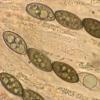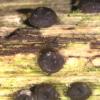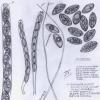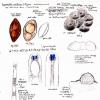
15-12-2025 07:09
 Danny Newman
Danny Newman
indet. Rutstroemiaceae sp. on unk. fallen leavesMc

15-12-2025 21:11
 Hardware Tony
Hardware Tony
Small clavate hairs, negative croziers and IKI bb

15-12-2025 15:54
 Johan Boonefaes
Johan Boonefaes
Unknown anamorph found on the ground in coastal sa

15-12-2025 15:48
 Danny Newman
Danny Newman
Melanospora cf. lagenaria on old, rotting, fallen

15-12-2025 07:05
 Danny Newman
Danny Newman
Pseudosclerococcum golindoi (det: Zotto)near Cosb

15-12-2025 11:49
 Danny Newman
Danny Newman
ITS sequences from the following two collections B

15-12-2025 12:34
 Danny Newman
Danny Newman
indet. Rhytismataceae on oak leafnear Purchase Roa

09-12-2025 12:06
 Andgelo Mombert
Andgelo Mombert
Bonjour,Je recherche l'article concernant Hypobryo
Xylariaceae
Fernández Vicente Javier,
23-03-2006 13:50
Desearía si fuera posible que me indicarais de cual podría tratarse esta Xylariaceae (Rosellinia).
Ascocarpo, de 0,8-1,5 mm, piriforme, negro, solitarios o juntos.
Ascosporas: (15,2)16-20,11x7,2-9,65 (10,5) micras. uniseriadas, elipsoidales, hialinas a marrones, multigutuladas; a veces una o dos grandes y varias pequeñas, con una linea central en la madurez, Burbuja de Bari, presente.
Ascas: 152-172x9-12 micras, cilindricas. J+.
Parafisos: hialinos, 400-480x4-5 micras.
Habitat: Rubus sp, Rosa sp.
Saludos a todos, Javier.
Christian Lechat,
23-03-2006 14:42

Re:Xylariaceae
Bonjour,
visiblement sur la photo il n'y a pas de subiculum, pouvez vous le confirmer?
Par ailleurs, il semble que les spores de la photo soient immatures.
Amitiés, :)
visiblement sur la photo il n'y a pas de subiculum, pouvez vous le confirmer?
Par ailleurs, il semble que les spores de la photo soient immatures.
Amitiés, :)
Enrique Rubio,
23-03-2006 17:09
Re:Xylariaceae
Parecen inmaduras las ascósporas. Intenta definir la morfología de la hendidura germinativa. Rosellinia es un género muy difícil. Tienes una página web: http://pyrenomycetes.free.fr/rosellinia/index.htm dedicada al género con unas claves también muy complicadas.
Saludos
Saludos
Fernández Vicente Javier,
23-03-2006 17:39
Jacques Fournier,
23-03-2006 17:41

Re:Xylariaceae
Bonjour Javier,
je pense que tu devrais chercher du côté de Rosellinia mammaeformis tel que Petrini l' a redéfini (Sydowia 1989), bien que la dimension des stromas soit un peu plus grande. A part la dimension et la forme des spores, le caractère distinctif est la présence de deux appendices gélatineux aux extrémités de la spore. Pas toujours facile à voir!
R. mammaeformis est une espèce rarement rencontrée, j'étudierais volontiers ton specimen.
Amitiés,
Jacques Fournier
je pense que tu devrais chercher du côté de Rosellinia mammaeformis tel que Petrini l' a redéfini (Sydowia 1989), bien que la dimension des stromas soit un peu plus grande. A part la dimension et la forme des spores, le caractère distinctif est la présence de deux appendices gélatineux aux extrémités de la spore. Pas toujours facile à voir!
R. mammaeformis est une espèce rarement rencontrée, j'étudierais volontiers ton specimen.
Amitiés,
Jacques Fournier
Enrique Rubio,
23-03-2006 18:05
Re:Xylariaceae
Sigues siendo un gran dibujante. Tienes que tratar de ver esporas maduras. Ya sabes, más oscuras y con menos gútulas.
De todas maneras yo creo que poco voy a poder ayudarte
Un abrazo.
De todas maneras yo creo que poco voy a poder ayudarte
Un abrazo.
Fernández Vicente Javier,
23-03-2006 18:25
Re:Xylariaceae
Jacques, la R. mammaeformis, ya la conozco y la Rosellinia que estamos tratando, no he logrado ver en ninguna ocasión los apendices hialinos que me indicas y la he mirado bastante bien. Estas son más anchas y de forma diferente.
Saludos, Javier.
Saludos, Javier.
Fernández Vicente Javier,
24-03-2006 12:03
Re:Xylariaceae
Muchas gracias, Christian; Enrique; Jacques, por haberos molestado en mirar.
Saludos. Javier.
Saludos. Javier.
Hans-Otto Baral,
04-04-2006 22:01

Re:Xylariaceae
Hi
I can´t read Spanish and I can´t see the images in full size, but I wish to say that this collection reminds me of Nemania (Hypoxylon) confluens (see my DVD HB 3339). Couldn´t that be?
Zotto
I can´t read Spanish and I can´t see the images in full size, but I wish to say that this collection reminds me of Nemania (Hypoxylon) confluens (see my DVD HB 3339). Couldn´t that be?
Zotto
Jacques Fournier,
04-04-2006 23:15

Re:Xylariaceae
Hi Zotto,
I think it is a very good suggestion. In the cas of Nemania confluens the apical apparatus is often broader than high, while it is more tubular in Rosellinia. Hope Javier will tell us about this apical apparatus.
Jacques
I think it is a very good suggestion. In the cas of Nemania confluens the apical apparatus is often broader than high, while it is more tubular in Rosellinia. Hope Javier will tell us about this apical apparatus.
Jacques
Fernández Vicente Javier,
05-04-2006 14:13
Re:Xylariaceae
Hola.
Si, podría tratarse de la Nemania confluens.
Estube mirando las nemanias y supongo que no me encajaban con ellas, por las ascosporas multigutuladas y el habutat.
Lo he vuelto a mirar y el aparato apical, también coincide con ella, es de forma cuboide como muy bien indicaba Jacques. Le he medido y me da con medidas de 2,8-3,2x3,4-4 micras.
Zotto, no he logrado verla en tu DVD HB 3339.
Muchas gracias a los dos, Zotto y Jacques.
Saludos, Javier.
Hola.
If, it might be a question of the Nemania confluens.
Estube looking at the nemanias and I suppose that they were not fitting me with them, for the ascosporas multigutuladas and the habutat.
I have turned it to looking and the device apical, also it(he,she) coincides with her(it), is of form cuboide as very well Jacques was indicating. I have measured him and it(he,she) me meets on measurements of 2,8-3,2x3,4-4 microns.
Zotto, I have not managed to see her in your DVD HB 3339.
Thank you very much to the two, Zotto and Jacques.
Regards, Javier.
Si, podría tratarse de la Nemania confluens.
Estube mirando las nemanias y supongo que no me encajaban con ellas, por las ascosporas multigutuladas y el habutat.
Lo he vuelto a mirar y el aparato apical, también coincide con ella, es de forma cuboide como muy bien indicaba Jacques. Le he medido y me da con medidas de 2,8-3,2x3,4-4 micras.
Zotto, no he logrado verla en tu DVD HB 3339.
Muchas gracias a los dos, Zotto y Jacques.
Saludos, Javier.
Hola.
If, it might be a question of the Nemania confluens.
Estube looking at the nemanias and I suppose that they were not fitting me with them, for the ascosporas multigutuladas and the habutat.
I have turned it to looking and the device apical, also it(he,she) coincides with her(it), is of form cuboide as very well Jacques was indicating. I have measured him and it(he,she) me meets on measurements of 2,8-3,2x3,4-4 microns.
Zotto, I have not managed to see her in your DVD HB 3339.
Thank you very much to the two, Zotto and Jacques.
Regards, Javier.
Hans-Otto Baral,
09-04-2006 22:32
Fernández Vicente Javier,
09-04-2006 23:50
Re:Xylariaceae
Hello Zotto:
Thank you very much, very interesting drawing.
It is sufficient with what you have sent to me.
Regards, Javier.
Thank you very much, very interesting drawing.
It is sufficient with what you have sent to me.
Regards, Javier.



